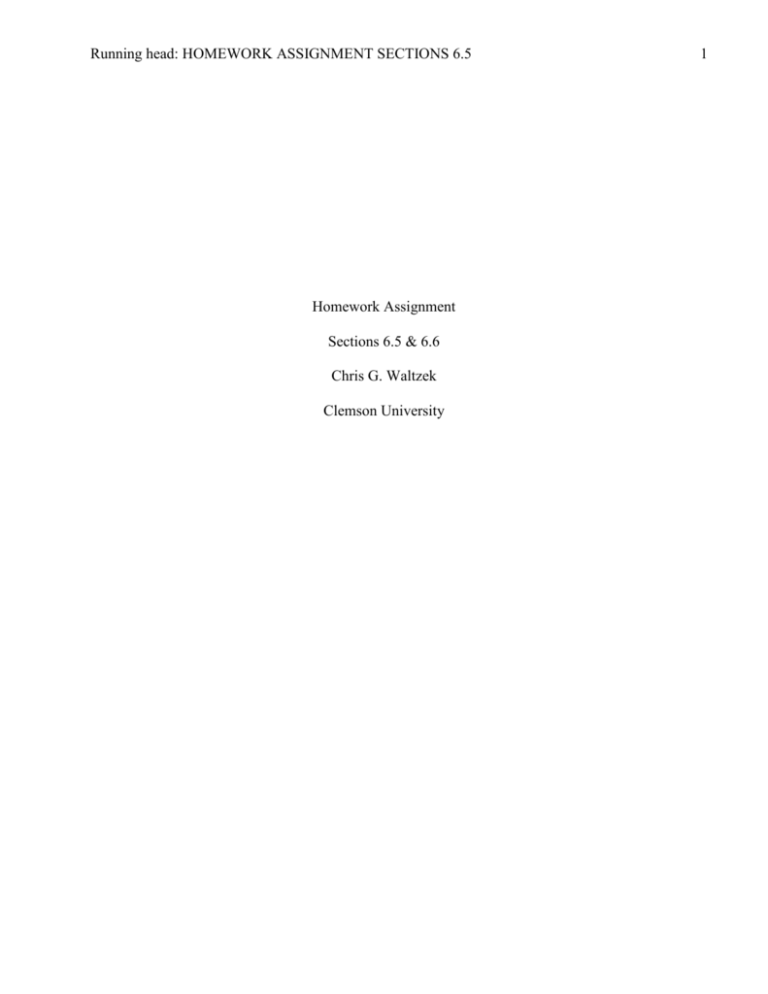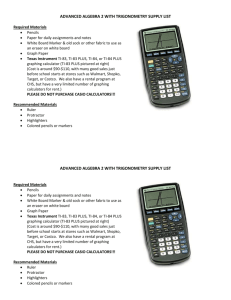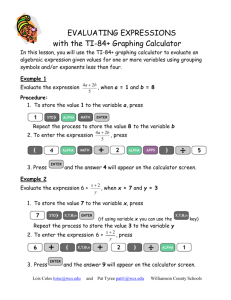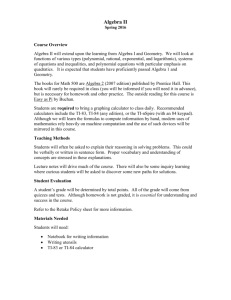
Running head: HOMEWORK ASSIGNMENT SECTIONS 6.5
Homework Assignment
Sections 6.5 & 6.6
Chris G. Waltzek
Clemson University
1
HOMEWORK ASSIGNMENT SECTIONS 6.5 & 6.6.
Homework Assignment Sections 6.5 & 6.6
Section 6.5
Complete the following problems from you textbook (an e-copy of the book is available on
WebAssign). Due: your first class following fall break (e.g. Nov 5 or 6).
Section 6.5: 21, 22, 25, 26, 28, 29, 34
Q.21 The function f(w) is a probability density function (PDF) because it satisfies two key
criteria:
∞
1. ∫−∞ 𝑓(𝑤)𝑑𝑤 = 1.
1
Verified via TI-84: ∫0 𝑓(𝑤)𝑑𝑤 = 1.
2. f(w) ≥ 0 for each real number w, as verified in the TI-84 graphing function.
Q.22 The function h(x) is a probability density function (PDF) because it satisfies two key
criteria:
∞
1
1. ∫−∞ ℎ(𝑥)𝑑𝑥 = 1. Verified via TI-84: ∫0 ℎ(𝑥)𝑑𝑥 = 1.
2. h(x) ≥ 0 for each real number x, as verified in the TI-84 graphing function.
Q.25 No, the function h(y) is not a probability density function (PDF) because it fails to satisfy
the two key criteria:
∞
𝑁
1. ∫−∞ ℎ(𝑦)𝑑𝑦 ≠ 1. Verified via TI-84: lim ∫0 ℎ(𝑦)𝑑𝑦 ≈ .391
𝑁→∞
2. h(y) ≠ 0 when y ≤ 0 for each real number y, as verified in the TI-84 graphing function.
2
HOMEWORK ASSIGNMENT SECTIONS 6.5 & 6.6.
3
Q.26 The function f(t) is not a probability density function (PDF) because it fails to satisfy the
two key criteria:
∞
𝑁
1. ∫−∞ 𝑓(𝑡)𝑑𝑡 ≠ 1. Verified via TI-84: lim ∫1.8 𝑓(𝑡)𝑑𝑡 ≈ 5.26.
𝑁→∞
2. f(t) ≠ 0 when t < 1.8 for each real number t, as verified in the TI-84 graphing function.
Q.28 The total number of hours (h) a student spends each day on Twitter, is distributed
according to the density function T(h), for: 0 ≤ h ≤ 24; 0 elsewhere.
∞
a. T is a PDF, because ∫−∞ 𝑇(ℎ)𝑑ℎ = 1. Verified via TI-84:
0
24
∞
∫−∞ 𝑇(ℎ)𝑑ℎ = 0; ∫0 𝑇(ℎ)𝑑ℎ = 1; ∫24 𝑇(ℎ)𝑑ℎ = 0; ∴ 0 + 1 + 0 = 1
b. The probability that the student will spend between 0.75 hours and 1.2 hours tomorrow on
1.2
Twitter: ∫.75 𝑇(ℎ)𝑑ℎ = 26.8%
c. A graph of T with the region whose area includes the answer to part a, is reviewed (see Figure
1.1).
Figure 1.1. PDF: T(h)
Note: The figure is from Calculus Concepts (2014), All Rights Reserved.
HOMEWORK ASSIGNMENT SECTIONS 6.5 & 6.6.
4
Q.29 The manufacturer of a new board game believes that the time it takes a child between the
ages of 8 and 10 to learn the rules of this game has the probability density function g(t), when: 0
≤ t ≤ 4; 0 elsewhere, where t = minutes.
4
a. The mean (µ) time it takes a child age 8 to 10 to learn the rules of this game: µ = ∫0 𝑔(𝑡)𝑑𝑡 =
2 minutes.
b. Calculate the standard deviation (σ) of the learning times:
4
σ =√∫0 (𝑡 − 2)2 𝑔(𝑡)𝑑𝑡 = .894
3
c. P(t ≤ 3) = ∫0 𝑔(𝑡)𝑑𝑡 = .844; when 0 ≤ t ≤ 3. The probability that a child age 8 to 10 learns the
rules of this game in less than three minutes is 84.4%.
Q.34 If g is a probability density function defined on -∞ ≤ x ≤ ∞, and a and b are real numbers
such that a < b, the following statement is true:
𝑏
𝑃(𝑥 < 𝑎) + 𝑃(𝑥 > 𝑏) = 1 − ∫ 𝑔(𝑥)𝑑𝑥
𝑎
The equation is true because the definition of a density function for a continuous or piecewisecontinuous function a ≤ x ≤ b otherwise x = 0 implies: 𝑃(𝑥 < 𝑎) + 𝑃(𝑥 > 𝑏) = 0. The
definition of a density function for a continuous or piecewise-continuous function
∞
𝑏
∫−∞ 𝑓(𝑥)𝑑𝑥 = 1; which implies: 1 − ∫𝑎 𝑔(𝑥)𝑑𝑥 = 0.
Therefore, it follows:
𝑏
𝑃(𝑥 < 𝑎) + 𝑃(𝑥 > 𝑏) = 1 − ∫ 𝑔(𝑥)𝑑𝑥;
𝑎
[0 + 0] = [1 − 1];
[0] = [0]
HOMEWORK ASSIGNMENT SECTIONS 6.5 & 6.6.
5
Section 6.6: 2, 3, 5-7, 11, 13, 21, 26
Q.2 If x is a random variable with a uniform density function for 0 ≤ x ≤ 1, its cumulative
distribution function F(x) = 0 for x < 0, is x for 0 ≤ x ≤ 1 and 1 for x > 1. Yes, all three
statements are correct, because F(x) remains at 1 when x > 1; the right end behavior of any
cumulative distribution function is 1, representing certain events. The left end behavior of any
cumulative distribution function is zero representing impossible events. Cumulative distribution
functions always increase.
Q.3 False, the value of k that makes G(t) an exponential density function is k = 1.
Q.5 The graph of G(t) is a possible accumulation density function because due to its nondecreasing nature.
Q.6 The graph of C(m) is not an accumulation density function because it is decreasing where 0
≤ m < 5.
Q.7 The graph of S(x) is not a cumulative density function because S(x) ≠ 0, when x < 0.
Verbally: left end behavior appears to approach, yet not reach, zero.
Q.11 At a certain grocery checkout counter, the average waiting time is 2.5 minutes. Suppose
the waiting times follow an exponential density function.
a. The equation for the exponential distribution of waiting times follows (µ = 2.5; k = 1 / 2.5 =
.4):
f(x) = 𝑘𝑒 −𝑘𝑥 for 𝑥 ≥ 0; f(x) = . 4𝑒 −.4𝑥 for 𝑥 ≥ 0.
The mean of an exponential distribution is 1/k. A graph of the equation and location of the mean
waiting time is illustrated (see Figure 1.2).
Figure 1.2 Graph of Equation & Mean Waiting Time
HOMEWORK ASSIGNMENT SECTIONS 6.5 & 6.6.
6
Note: The Figure is from Calculus Concepts (2014), All Rights Reserved.
b. What is the likelihood that a customer waits less than 2 minutes to check out?
2
𝑃(𝑥 < 2) = ∫0 . 4𝑒 −.4𝑥 𝑑𝑥 = 55% Greater than even odds.
4
c. What is the probability of waiting between 2 and 4 minutes? 𝑃(2 < 𝑥 < 4) = ∫2 . 4𝑒 −.4𝑥 𝑑𝑥 =
24.7%
d. What is the probability of waiting more than 5 minutes to check out?
∞
𝑁
𝑃(𝑥 > 5) = ∫ . 4𝑒 −.4𝑥 𝑑𝑥 = lim ∫ . 4𝑒 −.4𝑥 𝑑𝑥 =
𝑁→∞ 5
5
lim [.4𝑒 −.4𝑁 /−.4 – (.4𝑒 −.4(5) )/−.4] =
𝑁→∞
lim [−𝑒 −.4𝑁 – (−𝑒 −.4(5) )] =
𝑁→∞
0 – (−.135) ≈ 13.5%
Q.13 Luggage Weight - Suppose the weight of pieces of passenger luggage for domestic airline
flights follows a normal distribution, where µ = 40 𝑝𝑜𝑢𝑛𝑑𝑠; σ = 10.63 pounds.
a. Calculate the probability that a piece of luggage weighs less than 45 pounds. 𝑃(𝑤 < 45) =
45
2 /(2(10.63)2 )
∫0 (1/(10.63√2𝜋)𝑒 −(𝑤−45)
) 𝑑𝑤 = 68.1%
HOMEWORK ASSIGNMENT SECTIONS 6.5 & 6.6.
7
b. Calculate the probability that the total weight of the luggage for 80 passengers on a particular
flight is between 1200 and 2400 pounds (Assume each passenger has one piece of luggage).
30
2 /(2(10.63)2 )
𝑃(15 < 𝑤 < 30) = ∫15 (1/(10.63√2𝜋)𝑒 −(𝑤−40)
) 𝑑𝑤 = 16.4%
c. Calculate where the probability density function for the weight of passenger luggage is
decreasing most rapidly. Next, f ’(w) has a minimum at w = 50.63 pounds therefore f(w) has an
inflection point at w = 50.63 pounds which is the weight of passenger luggage that decreases
most rapidly.
Q.21 The cumulative distribution function F follows (see Figure 1.3).
Figure 1.3. Cumulative Distribution Function F
Note: The Figure is from Calculus Concepts (2014), All Rights Reserved.
Q.26 Given the following density function, the three questions follow:
𝑔(𝑥) = {
. 25, when 5 ≤ 𝑥 ≥ 9;
0, when 𝑥 < 5 or 𝑥 > 9,
a. The corresponding cumulative density function (G) is identified via the anti-derivative of .25
(.25x):
HOMEWORK ASSIGNMENT SECTIONS 6.5 & 6.6.
0, when 𝑥 < 5;
𝐺(𝑥) = {. 25𝑥, when 5 ≤ 𝑥 ≤ 9;
1, when 𝑥 > 9.
b. Both g and G identify the probability that x < 6.08:
6.08
g: ∫5
𝑔(𝑥)𝑑𝑥 = 27%
G: G(6.08) – G(5) = .25(6.08) – .25(5) = 1.52 – 1.25 = 27%
c. The graphs of g and G follow, respectively (see Figures 1.4 & 1.5).
Figure 1.4. Graph of g
Note: The Figure is based on a question from Calculus Concepts (2014), All Rights Reserved.
Figure 1.5. Graph of G
8
HOMEWORK ASSIGNMENT SECTIONS 6.5 & 6.6.
Note: The Figure is based on a question from Calculus Concepts (2014), All Rights Reserved.
9









